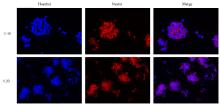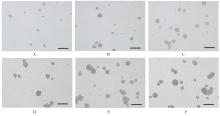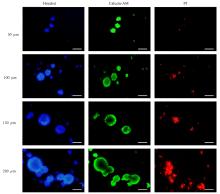吉林大学学报(医学版) ›› 2023, Vol. 49 ›› Issue (6): 1642-1648.doi: 10.13481/j.1671-587X.20230632
胎鼠神经干细胞原代培养及传代条件优化
- 吉林大学第一医院神经创伤外科,吉林 长春 130021
Primary culture and optimization of subculture conditions of neural stem cells from fetal rats
Wenhao ZHU,Tianyi LIU,Chuan HE,Xiaoyu ZHANG,Qiang XIN,Haifeng WANG( )
)
- Department of Neurotrauma Surgery,First Hospital,Jilin University,Changchun 130021,China
摘要:
目的 探讨胎鼠神经干细胞(NSCs)原代培养方法和活性评价体系,确定NSCs的最佳传代条件。 方法 选取孕11~14 d SD大鼠,提取胎鼠原代NSCs,采用巢蛋白免疫荧光染色鉴定NSCs。将NSCs以1.0×104、2.0×104、6.0×104、1.0×105、1.6×105和2.0×105 mL-1的细胞密度进行传代培养48 h后观察神经球的形态表现,测定神经球直径。活死细胞染色法检测不同直径神经球中NSCs存活率。 结果 NSCs呈巢蛋白阳性,培养的细胞为神经干细胞。NSCs呈聚集生长和牢固细胞间黏附聚集模式,形成神经球,平均直径为(152.72±47.52)μm,球与球之间少有单独的细胞散在。与2.0×104 mL-1传代密度比较,6.0×104 mL-1 和1.0×105 mL-1 传代密度的神经球直径增大(P<0.05)。1.0×105 mL-1 、1.6×105 mL-1 和2.0×105 mL-1 传代密度的神经球直径比较差异无统计学意义(P>0.05)。与0~40 μm、40~60 μm、60~80 μm和80~100 μm直径神经球比较,100~200 μm直径神经球中NSCs存活率降低(P<0.05)。 结论 以1.0×105 mL-1的密度进行传代时神经球直径为80~100 μm,可有效提高NSCs传代培养效率和活性。
中图分类号:
- Q254










